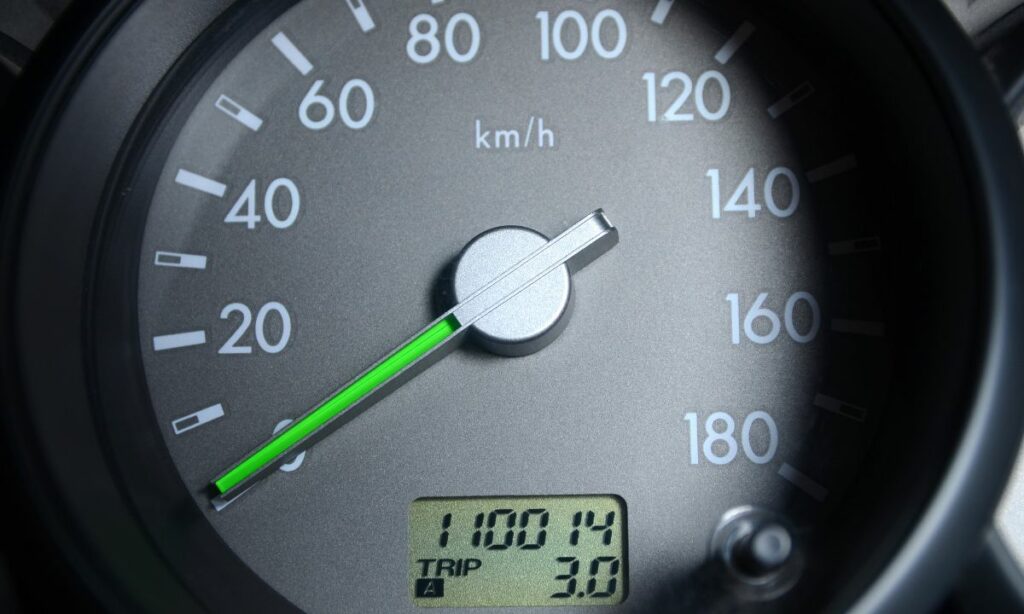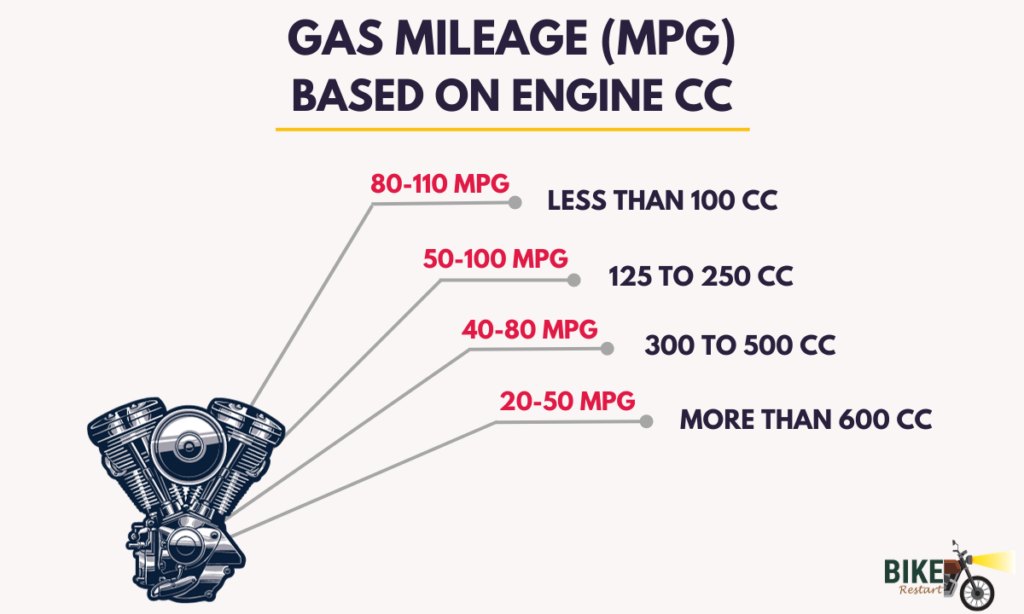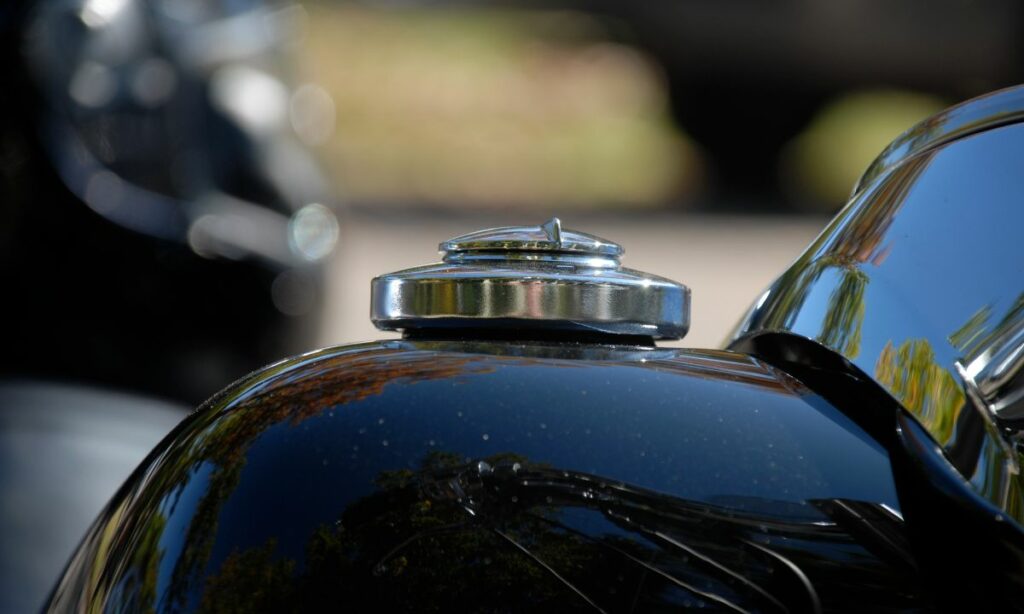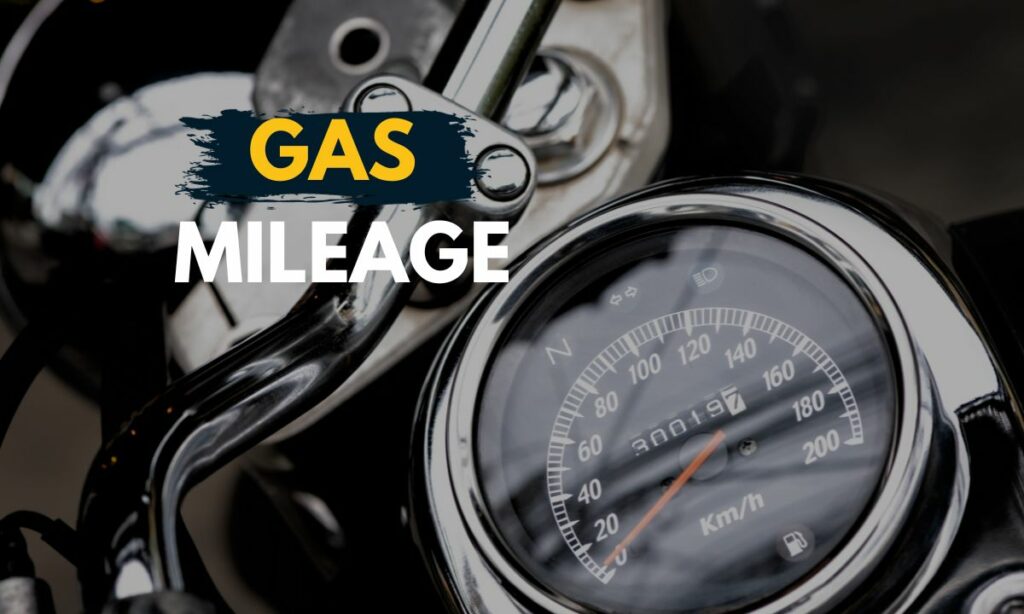Gas mileage, fuel economy, fuel efficiency – all mean the same and measure the same thing.
In this post, we are going to look into motorcycle gas mileage in detail. We are covering:
- What exactly is gas mileage and its formula
- What’s a good gas mileage for a motorcycle
- Methods to calculate
- Gas mileage calculator
- How fuel consumption and fuel economy are different
- And many more
So, let’s dig in.
What is gas mileage?
Gas mileage is the measure of the distance traveled by a motorcycle consuming a unit amount of fuel.

Most commonly, the motorcycle gas mileage is measured in miles per gallon (MPG).
Another common measure is kilometers per liter (km/L).
Put simply, the motorcycle gas mileage tells you how far can your motorcycle travel per amount of fuel (gallon or liter).
Gas mileage is a measure of a motorcycle’s fuel efficiency. The higher the gas mileage, the better it is. Low fuel is consumed. And less cost on fuel.
Formula
Here is the formula for motorcycle gas mileage:
Gas mileage = Distance traveled by the motorcycle / Amount of fuel consumed
Since the gas mileage is commonly measured in miles per gallon (MPG), here is what the MPG formula looks like:
where: MPG stands for miles per gallon.
If the motorcycle travels 120 miles of distance and consumes 3 gallons of fuel, then the gas mileage of the motorcycle comes to 40 MPG.
Similarly, a similar formula can be used to calculate the fuel efficiency in terms of kilometers per liter (km/L).
If the motorcycle traveled a distance of 100 kilometers and consumed 2.5 liters of fuel, then the gas mileage of the motorcycle is 40 km/L.
What is a good gas mileage for motorcycles?
The gas mileage of a motorcycle can range from 40 MPG to 70 MPG depending on the make, type, weight, cc, accessories, and motorcycle maintenance.
In general, lower-weight and lower-cc motorcycles have higher gas mileage than motorcycles with higher curb weight and engine cc.
Similarly, performance motorcycles usually provide higher gas mileage than cruisers or sport bikes.
Even the same type of motorcycle but different brands can give you different MPGs.
Let’s take a look at how different the MPGs look based on different parameters.
#1. Motorcycle Type
The type of motorcycle plays a large role in determining the motorcycle’s gas mileage.
Here is what the MPGs look like on different motorcycle types:
| Motorcycle Type | Gas Mileage |
|---|---|
| Cruisers | 30 to 50 MPG |
| Street & Standard Bikes | 40 to 70 MPG |
| Sport & Touring Bikes | 35 to 60 MPG |
| Supersport and Racing Bikes | 20 to 40 MPG |
Not surprisingly, street bikes and standard motorcycles give the best gas mileage. Which they are built for. That’s one of the reasons these category motorcycles are called performance motorcycles.
#2. Engine CC
The motorcycle’s engine cc plays an important role too. The higher the engine cc, the lower the gas mileage.

Engine capacity and the motorcycle curb weight are closely correlated. You can view it as – the higher the engine cc, the higher the weight, and the lower the gas mileage.
Here is how engine cc affects the gas mileage for motorcycles:
| Engine CC | Gas Mileage |
|---|---|
| <100 cc | 80 to 110 MPG |
| 125 to 250 cc | 50 to 100 MPG |
| 300 to 500 cc | 40 to 80 MPG |
| 600 and above cc | 20 to 50 MPG |
#3. Motorcycle weight
In general, the heavier the motorcycle, the lower its gas mileage.
This is common sense.
The engine needs more power to move a heavy object than a lightweight object. So it has to burn more fuel.
That’s why it’s no surprise when street bikes have better gas mileage than cruisers. When the 150cc motorcycle gives higher MPG than a 600cc bike.
The same point can be extrapolated to accessories. With more accessories (especially the heavier ones) you add to your motorcycle, expect the gas mileage to go down.
#4. Maintenance
A well-maintained motorcycle gives a higher gas mileage than a poorly maintained one.
This might not sound much. But it makes a huge difference as the motorcycle gains years (the power of compounding you see).
10 years into owning a motorcycle, the gas mileage difference can be as high as 20 to 30 MPGs.
That’s why we should maintain our motorcycles well.
How to calculate motorcycle gas mileage
Calculating gas mileage comes down to high school mathematics. We all do it in our own ways.
Here are the 2 most common methods we knowingly or unknowingly use to calculate:
- Method 1: Full tank method
- Method 2: Reserve tank method
Method 1: Full tank method
This is the simplest approach to calculating a motorcycle’s gas mileage.
We all do it this way.
In case, things are not clear, here is a detailed step-by-step procedure you need to follow.
Steps:
Step 1: Take your motorcycle to the fuel pump.
Step 2: Fill the fuel tank to its full capacity. The fuel level should reach the fuel tank brink.
Step 3: Note down the odometer reading at the fuel pump. The distance reading acts as the reference starting point. If you can reset the trip meter, do that. It’s much better (the initial reading is zero).
Step 4: Ride the motorcycle for sufficient distance. A good thumb rule is to ride the bike for a week or two, or travel an approximate distance of 100 miles.
Step 5: It’s time for fuel refill. Take your motorcycle to the fuel pump again.
Step 6: Note down the odometer reading at the fuel pump now. This distance reading acts as the ending point. The difference between this final reading and the initial reading gives you the actual distance traveled.
Step 7: Fill the fuel tank to full again. Note down the amount of fuel required to fill the fuel tank to its brink.
Step 8: We now have both the distance traveled (from odometer readings). The amount of fuel used (from the fuel required to fill it back completely). Divide the distance traveled by the amount of fuel used, and you will now have the mileage figure
Calculation example
Say:
The distance traveled = (Final – Initial) odometer readings = 130 miles
Fuel refilled = 2.5 gallons
Gas mileage = 130/2.5 = 52 MPG
Method 2: Reserve tank method
Another method is to use the motorcycle reserve to your advantage for calculating the mileage of your motorcycle.
Note: This method works only for carbureted motorcycles that have a reserve tank and fuel petcock.
Here’s how to do it:
Steps:
Step 1: Ride your motorcycle until the fuel empties and you hit the ‘reserve’.
Step 2: Note down the odometer reading. This will act as the starting reference point for the distance covered. Alternatively, you can set the trip meter to zero.
Step 3: You can now ride only in Reserve. Turn the fuel tap to the reserve (‘RES’) and ride to the nearest fuel pump.
Step 4: Fill the fuel tank with exactly 1 gallon of gas. You can also fill with any amount of fuel as long as you note down the fuel amount you have filled in the tank. You adjust that by dividing the distance calculation.
Step 5: Turn the fuel tap back to the ‘ON’ position.
Step 6: Ride the motorcycle to your heart’s content until the motorcycle empties that 1-gallon fuel and hits the reserve again.
Step 7: Note down the final odometer reading again now.
Step 8: We now have two odometer readings. The difference between the final and initial reading is the actual distance traveled. And since the fuel consumed is 1 gallon. The distance traveled gives you the mileage of your motorcycle.
Calculation example
Say:
The distance traveled = (Final – Initial) odometer readings = 47 miles
Fuel used = 1 gallon
Gas mileage = 47/1 = 47 MPG
Gas Mileage Calculator
For a detailed version of the gas mileage calculator, you can check here.
Gas mileage, fuel economy, fuel efficiency – are all the same
While gas mileage and MPG are the popular terms we use, fuel economy and fuel efficiency essentially mean the same as gas mileage as well.
They all refer to how much distance our motorcycle can travel per unit of fuel.

It’s different people using different names. that’s all there to it.
Also, while MPG (miles per gallon) is the popular measure of gas mileage (or fuel economy or fuel efficiency), Km/L (kilometers per liter) is another popular metric.
If you are in the US, you would prefer MPG. And if you are in the UK, you would prefer Km/L.
It’s the imperial system vs the metric system.
And here is what the conversion looks like:
1 MPG = 0.425 Km/L
1 Km/L = 2.352 MPG
Fuel consumption is slightly different from gas mileage
Although gas mileage and fuel consumption are both focusing on distance traveled and the fuel consumed, they are not the same.
Fuel consumption measures the amount of fuel consumed by a vehicle to travel 100 kilometers.
Gas mileage or fuel economy, on the other hand, measures the distance traveled by a vehicle per unit of fuel consumed.
It’s kind of inverse. But the core remains the same.
You want a higher gas mileage and lower fuel consumption for your motorcycle.
Here is what the relationship between the two look like:
Fuel Consumption (L/100Km) = 100 / Gas mileage (Km/L)
Gas mileage (Km/L) = 100 / Fuel Consumption (L/100Km)
Similarly, if you are measuring gas mileage in MPG:
Fuel Consumption (L/100Km) = 42.51 / Gas mileage (MPG)
Gas mileage (MPG) = 42.51 / Fuel Consumption (L/100Km)
It’s all simple mathematics. If it’s still confusing, relax, and google conversion calculator. You will be fine.
Tips to improve motorcycle gas mileage
Here are a few tips and tricks to improve your motorcycle gas mileage:
- Maintain good tire pressure: Low-pressure tires exert more load on the engine. Inflate air and maintain optimum pressure on both tires.
- Use high-quality fuel: Good-quality gasoline makes a large difference in gas mileage as well as engine maintenance. Go for premium gasoline, unleaded, and with a higher octane rating.
- Keep the air filter clean: A clogged or blackened air filter blocks air entry into the engine. Impacting fuel combustion and fuel economy. Clean the air filter and replace it if it’s black already.
- Use good engine oil: Low oil levels or poor oil quality stresses the engine. Use a high-quality oil (you can try semi or synthetic if your bike allows) and of the right grade.
- Maintain the spark plugs: A Clean spark plug is essential for engine ignition. Make sure you are using a good-condition spark plug with the electrodes visible and not masked.
- Ensure the chain is tight and lubricated: Make sure the chain is not loosened. It must be clean. Tight. And well lubricated.
- Ride on good roads: Riding on good highways gives you a higher motorcycle gas mileage than riding on poor or gravel roads.
- Don’t gear shift, brake-and-accelerate unnecessarily: Too much gear shifting, changing speeds, braking and accelerating unnecessarily rather than riding at a constant speed affects fuel economy. Avoid it.
- Service the motorcycle regularly: You should service your motorcycle every 3000 miles. And make sure the servicing covers all parts’ motorcycle maintenance.
FAQs
Absolutely. While there are many variables, motorcycles are far better than cars in gas mileage. Usually, motorcycles provide 3X to 4X times higher gas mileage than cars.
The average gas mileage of a motorcycle comes anywhere between 40 MPG to 70 MPG depending on the make, type, weight, cc, accessories, and motorcycle maintenance.
Lightweight, low cc, performance motorcycles can get a gas mileage of 100 MPG. A 150 cc street bike does give a fuel economy of 70 to 110 MPG.
Depends a lot on gas tank volume and fuel economy. Typically, a motorcycle can go between 150 to 400 miles in one tank.
Assuming the motorcycle gas tank capacity is 4 gallons and the gas per gallon price of $3, it costs $12 to fill up a motorcycle.
Final Words
A good gas mileage for a motorcycle is around 40 to 80 MPG depending on the motorcycle type, engine cc, weight, accessories, and maintenance.
As long as the gas mileage is not abysmally low, you should be fine.
Also, gas mileage, fuel economy, and fuel efficiency all mean the same thing. Measure in MPG or Km/L.
But fuel consumption is slightly different. Measured as the inverse of ga mileage per 100 km distance.
The only variable you can control to improve your gas mileage is the maintenance part. So regularly service your motorcycle and keep it in good health.
Before you go…
Here are a few more related posts for you:
